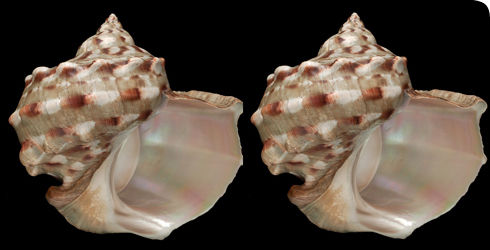Invasion History
First Non-native North American Tidal Record:First Non-native West Coast Tidal Record:
First Non-native East/Gulf Coast Tidal Record:
General Invasion History:
Turbo marmoratus has a wide native range from South and East Africa, east to Japan, Indonesia, Australia, and Fiji. It occurs on the crest and slopes of coral reefs (Poutiers 1987; Academy of Natural Sciences of Philadelphia 2014a, b; Museum of Comparative Zoology 2014). It has been successfully introduced to French Polynesia, where it is harvested for its shells and mother-of pearl (Bourgeois et al. 1997). It was found on newly planted oysters in Samish Bay, Washington in 1924, but has not been seen in North American waters since (Kincaid 1947, cited by Hanna 1966; Carlton 1979; Carlton 1992).
North American Invasion History:
Invasion History on the West Coast:
In 1924, Kincaid found specimens that he identified as Turbo marmoratus on newly planted Pacific Oysters (Crassostrea gigas) from Japan in Samish Bay, Washington (Kincaid 1947 cited by Hanna 1966 and Carlton 1979). There are no further records of T. marmoratus in North American waters.
Invasion History Elsewhere in the World:
Turbo marmoratus was introduced from Vanuatu to Tahiti in 1967, for fisheries. The snail is used as food, and the shell sold as a curio, and for mother-of-pearl used in buttons and inlays (Bourgeois et al. 1997; Poutiers 1998). It has also been introduced to Samoa (in 1999) and Tonga (in 1993) (Food and Agricultural Organization 2010), but its establishment is uncertain.
Description
Turbo marmoratus is a large herbivorous snail. It has a thick, heavy shell, dextrally coiled and roughly turban-shaped. The body whorl is large, with a small, pointed spire. The length of the shell is roughly equal to the width. The spire whorls are rounded, but the body whorl has an angular shoulder. The shell is marked with fine axial growth lines and three large spiral ribs, bearing blunt tubercles. The aperture is very large, forming 2/3 of the length of the shell, and is nearly circular, surrounded by a thick pearly lip. The operculum is calcareous, with a granular surface. The shell can reach 180 to 220 cm in length. The color ranges from dull uniform green to having spiral bans of chestnut. Description from: Richmond 1997, cited by Appeltans et al. 2014, and Poutiers 1998.
Taxonomy
Taxonomic Tree
| Kingdom: | Animalia | |
| Phylum: | Mollusca | |
| Class: | Gastropoda | |
| Subclass: | Prosobranchia | |
| Order: | Archaeogastropoda | |
| Family: | Turbinidae | |
| Genus: | Turbo | |
| Species: | marmoratus |
Synonyms
Turbo regenfussi (Deshayes, 1843)
Turbo cochlus (Gmelin, 1791)
Turbo olearius (Linnaeus, 1758)
Turbo undulata (Röding, 1798)
Potentially Misidentified Species
Hanna (1966) suggested that the shells identified by Kincaid (1947) as T. marmoratus, may have actually been Chlorostoma lischkei (=Tegula lischkei), based on a shell found in an oyster shipment. However, adult shells of these two species are quite distinct.
Ecology
General:
Turbo marmoratus, the Green Turban snail, is an herbivorous marine gastropod. Sexes are separate and fertilization is external. The eggs are laid in gelatinous masses and hatch into planktotrophic larvae. The Green Turban inhabits the flats and slopes of coral reefs, but is also found in subtropical-warm-temperate regions where coral reefs are absent. It feeds on attached algae and plant detritus (Poutiers et al. 1998).
Food:
Microalgae, plant detritus
Consumers:
Humans
Trophic Status:
Herbivore
HerbHabitats
| General Habitat | Coral reef | None |
| General Habitat | Oyster Reef | None |
| Salinity Range | Euhaline | 30-40 PSU |
| Tidal Range | Subtidal | None |
| Vertical Habitat | Epibenthic | None |
Tolerances and Life History Parameters
| Maximum Width (mm) | 220 | None |
| Broad Temperature Range | None | Warm-temperate-Tropical |
| Broad Salinity Range | None | Euhaline |
General Impacts
Turbo marmoratus has not become established in North American waters, and has had no economic impacts there. However, in its native Indo-Pacific range, and in Polynesia, where it is introduced, it is a valuable fishery item. It is so heavily fished that wild populations are endangered in much of its range, making it an object of conservation and aquaculture efforts (Bourgeois et al. 1997; Natural History Museum 2014).Regional Impacts
| SP-XVI | None | Economic Impact | Fisheries | ||
| Turbo marmoratus has been introduced to French Polynesia, where it provides a economically important fishery for food and shell products (Bourgeois et al. 1997; Poutiers 1998). | |||||
Regional Distribution Map
Non-native
Native
Cryptogenic
Failed
Occurrence Map
References
Academy of Natural Sciences of Philadelphia 2002-2024a Malacology Collection Search. <missing URL>Academy of Natural Sciences of Philadelphia 2006-2014b OBIS Indo-Pacific Molluscan Database. <missing URL>
Appeltans, W. et al. 2011-2015 World Registry of Marine Species. <missing URL>
Bourgeois, B.; Payril, C.E; Bach, P. (1997) Proceedings of the 8th International Coral Reef Symposium, 2 <missing publisher>, <missing place>. Pp. 1351-1356
Carlton, James T. (1979) History, biogeography, and ecology of the introduced marine and estuarine invertebrates of the Pacific Coast of North America., Ph.D. dissertation, University of California, Davis. Pp. 1-904
Hanna, G. Dallas (1966) Introduced mollusks of Western North America, Occasional Papers of the California Academy of Sciences 48: <missing location>
Harvard Museum of Comparative Zoology 2008-2021 Museum of Comparative Zoology Collections database- Malacology Collection. <missing URL>
Natural History Museum (UK) 2014 <i>Turbo marmoratus</i> (great green turban shell). <missing URL>
Poutiers, J.M. (1998) FAO species identification guide for fishery purposes. The living marine resources of the Western Central Pacific., 1 Fisheries and Agricultural Organization, Rome. Pp. 363-648
Teitelbaum, Antoine; Rena, Sompert (2008) [The status of aquaculture of marine gastropods and bivalves on Vanatu], Le troca - Bulletin d’information de la CPS 14: 16-18
U.S. National Museum of Natural History 2002-2021 Invertebrate Zoology Collections Database. http://collections.nmnh.si.edu/search/iz/
